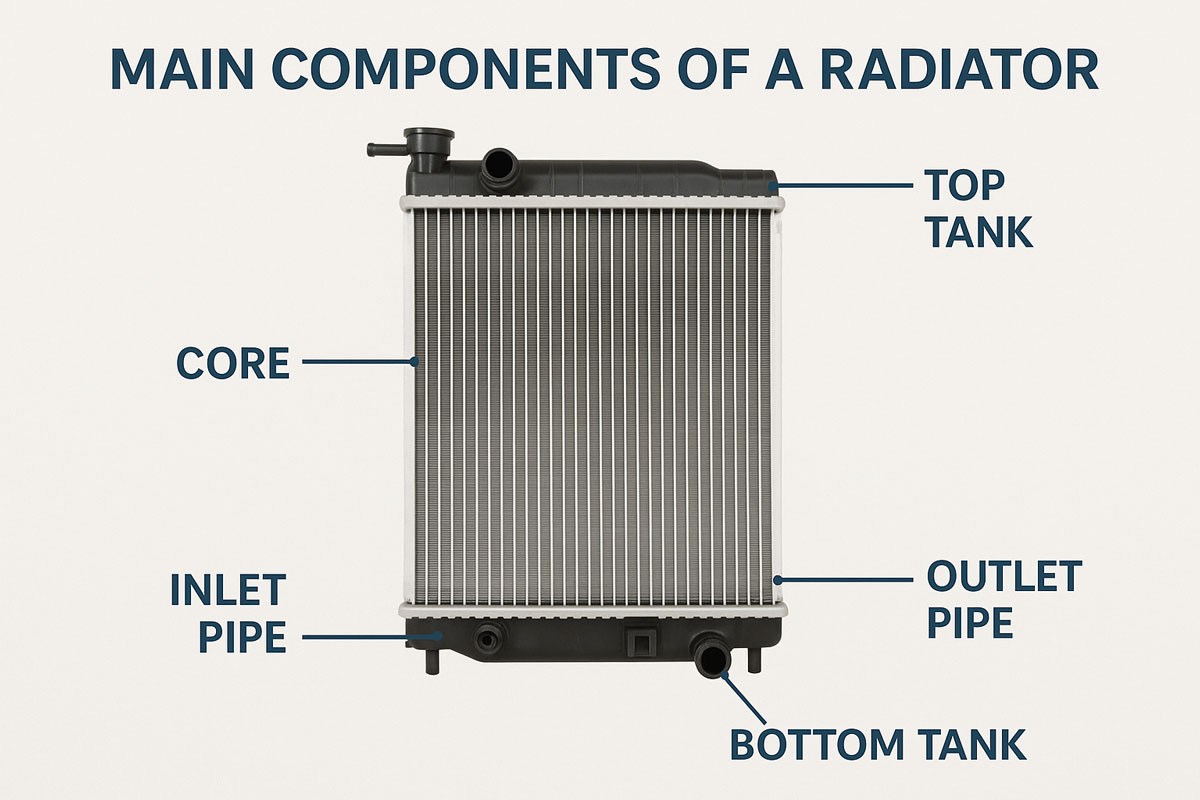Everything Smart Drivers in Canada Should Know About Automotive Radiators
Ever wondered what keeps your engine cool during those long summer drives or freezing winter mornings in Canada? Yup, it’s your
automotive radiator. Whether you’re a first-time car owner or a seasoned mechanic, understanding how your radiator works—and when it needs replacing—can save you thousands in repairs.
This guide explains everything you need to know, without the jargon. We’ll also show you why PMR (Paydar Mobaddal Radiator) is Canada’s trusted name in OEM radiators.

What Is an Automotive Radiator?
A radiator is part of your car’s engine cooling system. Its job? To keep your engine from overheating by transferring heat away through coolant and air.
“A car radiator is a cooling device that helps regulate engine temperature by releasing heat through coolant and airflow.”
It works in 3 basic steps:
- Coolant absorbs heat from the engine
- The hot coolant flows into the radiator
- The radiator cools the fluid using air flow, and sends it back to the engine

Main Components of a Radiator
- Core: The heart of the radiator. Where heat exchange happens.
- Inlet/Outlet Tanks: Where coolant flows in and out.
- Cooling Fins: Increase surface area to disperse heat faster.
- Radiator Cap: Seals pressure and allows expansion.
- Transmission Cooler: (in some models) Helps cool transmission fluid too.

Signs Your Radiator Needs Replacement
- Overheating engine
- Coolant leaking under the vehicle
- Discolored or sludgy coolant
- Frequent coolant top-ups
- Steam from the hood

OEM vs Aftermarket Radiators – Which One Should You Choose?
| Feature | OEM Radiator | Aftermarket Radiator |
|---|---|---|
| Fitment | Perfect match | May vary |
| Quality | Manufacturer-grade | Depends on brand |
| Reliability | Tested and trusted | May lack standardization |
| Cost | Higher upfront | Lower initial price |
Need OEM replacement? 👉 OEM Radiator Supplier in Canada
Radiator vs A/C Condenser – What’s the Difference?
- Radiator: Cools engine by circulating coolant
- A/C Condenser: Cools refrigerant for cabin air conditioning

👉 Browse A/C Condensers or Automotive Radiators.
Why Choose PMR (Paydar Mobaddal Radiator) for OEM Automotive Radiators in Canada?
- OEM-grade radiators with factory-fit
- Nationwide Canada shipping
- Affordable, durable, and reliable products
- Support for mechanics, shops, and direct consumers
Frequently Asked Questions (FAQ)
What does a car radiator do?
It cools the engine by transferring heat through coolant and air.
When should I replace my radiator?
Signs include overheating, leaks, and discolored coolant.
Is PMR a trusted OEM supplier?
Yes! PMR supplies OEM-grade radiators across Canada.
Does a bad radiator affect A/C?
Indirectly, yes. Engine heat can influence A/C performance.
Conclusion: Stay Cool with the Right Radiator
Your automotive radiator plays a critical role in your vehicle’s performance. Choose OEM quality. Choose PMR.
Explore more:
How Does a Radiator Work?
To understand why a radiator is crucial, it’s helpful to know how it works. The radiator operates as a heat exchange system for your car’s engine. When your engine runs, it generates intense heat. Without a proper cooling system, this heat would cause the engine components to expand, warp, or even fail entirely.
The coolant—a mix of water and antifreeze—circulates through the engine, absorbing the heat. This heated fluid then travels to the radiator. Inside the radiator, the hot coolant flows through narrow tubes connected to metal fins. As air moves over these fins—either from driving or a fan—it draws the heat away, cooling the fluid. The now-cooled liquid then returns to the engine to repeat the process.
Types of Radiators and Materials
Not all radiators are created equal. Here are the most common types:
- Aluminum Radiators: Lightweight and corrosion-resistant, often found in modern vehicles for better fuel efficiency.
- Copper-Brass Radiators: Excellent at conducting heat, usually found in older vehicles or heavy-duty applications. Heavier and more expensive.
- Plastic-Aluminum Radiators: Common in many consumer cars, offering affordability and decent performance, though they are less durable than full-metal options.
The choice of material can affect the radiator’s longevity, cost, and efficiency—so always consult your mechanic or supplier before purchasing.
Radiator Maintenance Tips
Proper maintenance of your radiator can extend its life and prevent costly breakdowns. Here’s how you can take care of it:
- Check coolant levels regularly: Low coolant can lead to overheating.
- Inspect for leaks: Look under your car for puddles or drips—these may indicate a failing radiator or hose.
- Flush the radiator: Over time, sediment and rust can accumulate. It’s best to flush your radiator every 2 years or 30,000 kilometers.
- Use the correct coolant: Mixing incompatible coolants can damage your radiator and other engine parts.
- Monitor temperature gauge: A consistently high reading may signal radiator issues.
When Should You Replace Your Radiator?
Radiators can last anywhere from 8 to 10 years, but this depends on driving conditions, maintenance, and quality. You should consider replacement when:
- The radiator is visibly corroded or cracked.
- Coolant turns brown or looks like sludge.
- Engine overheats frequently despite having enough coolant.
- You’re experiencing poor A/C performance due to overheating engine bay.
Tip: A new radiator may cost between $150 and $500 depending on your car model and whether you choose OEM or aftermarket parts.
Need Help Choosing the Right Radiator?
Choosing between OEM and aftermarket radiators can be tricky. OEM radiators are built to match your vehicle’s original specifications. At PMR ( Paydar Mobaddal Radiator ), we specialize in OEM-grade radiators that offer:
- Exact fitment
- Higher durability
- Nationwide support and delivery in Canada
Browse our full Automotive Radiator Catalog to find the right part for your car or truck.



